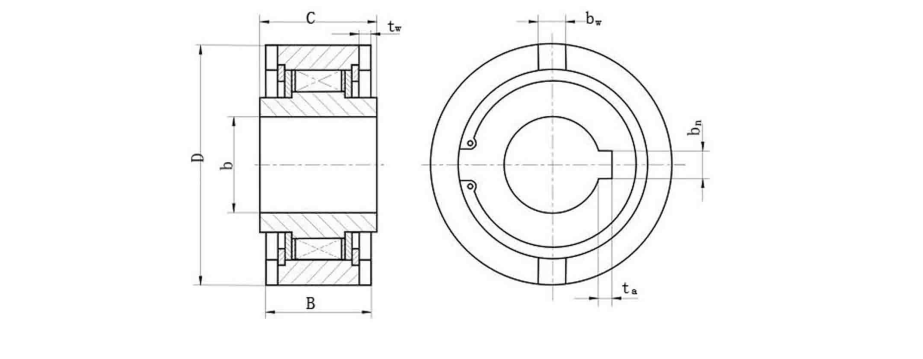Ное . 30, 2024 19:36 Back to list
Design and Applications of Axial Spherical Bearings in Mechanical Engineering
Understanding Axial Spherical Bearings An In-Depth Exploration
Axial spherical bearings are critical components in a variety of mechanical systems, providing support and facilitating smooth motion in applications where both axial and radial loads are present. These bearings are designed to accommodate misalignment and enable rotation or oscillation along a spherical surface. This article delves into the anatomy, working principles, applications, and advantages of axial spherical bearings.
Anatomy of Axial Spherical Bearings
At their core, axial spherical bearings consist of two primary components a spherical bearing race and a bearing ball or roller. The spherical race is typically mounted on a shaft or in a housing, allowing the internal bearing element to rotate freely within its confines. The race is concave, providing a matching spherical surface for the rolling element, which ensures that the loads are distributed across a wide area. This design minimizes wear and enhances longevity.
The bearings often feature materials that are both durable and smooth, such as steel or ceramic, which further increase their effectiveness under various loading conditions. Additionally, they may include seals or shields to protect against contaminants, thus ensuring the longevity of the bearing.
Working Principles
The working principle of axial spherical bearings revolves around the concept of rolling contact. When a load is applied to the bearing, the spherical geometry allows the rolling element to rotate smoothly within the curved surfaces of the race, distributing the load evenly. This capability enables these bearings to handle not only axial loads (forces that act parallel to the shaft) but also radial loads (forces that act perpendicular to the shaft).
One of the standout features of axial spherical bearings is their ability to accommodate angular misalignment
. This is particularly advantageous in applications where precise alignment is challenging due to installation tolerances or structural movements. The spherical nature of the bearing components allows for some degree of tilt, ensuring that the load is still appropriately supported.Applications
Axial spherical bearings find utility in numerous industries due to their versatility and performance capabilities. In automotive applications, they are commonly used in wheel hubs and suspension systems, where they support various loads while allowing for movement and adjustment. In industrial machinery, axial spherical bearings facilitate the smooth operation of rotating equipment, such as gearboxes, conveyors, and pumps.
axial spherical bearing

These bearings are also vital in agricultural machinery, like tillers and harvesters, where they help manage heavy loads and provide the necessary flexibility in motion. Additionally, they are used in aerospace applications, where precise movement and load management are crucial for safety and efficiency.
Advantages of Axial Spherical Bearings
1. Load Capacity Axial spherical bearings can handle high axial and radial loads, making them suitable for demanding applications.
2. Misalignment Accommodation Their spherical design allows for flexibility in alignment, reducing stress on connecting components and improving the overall lifespan.
3. Reduced Friction The rolling motion of the bearings minimizes friction compared to sliding contact bearings, resulting in enhanced efficiency and reduced wear.
4. Durability With the right materials and protective features, axial spherical bearings can withstand harsh environmental conditions, providing long service life.
5. Versatility These bearings are adaptable to a variety of applications across different industries, offering design flexibility and robust performance.
Conclusion
Axial spherical bearings are indispensable components in modern engineering, providing robust solutions for complex motion and load management challenges. Their unique design and functional benefits make them a popular choice across various industries, contributing to the efficiency and reliability of countless machines and systems. As technology continues to evolve, the demand for innovative bearing solutions like axial spherical bearings will likely grow, ensuring that these components remain at the forefront of mechanical design and application. Understanding their functionality, advantages, and applications is crucial for engineers and manufacturers aiming to optimize performance and longevity in their operational systems.
Latest news
-
GW315PPB11 Ball Round Hole Agricultural Bearings - Durable & Reliable.
NewsAug.28,2025
-
Top Spherical Roller Bearing Material Exporter - High-Performance Alloys
NewsAug.27,2025
-
Durable PLC 110-190 Spherical Roller Bearing for Mixer Reducer
NewsAug.26,2025
-
CSK-2RS Sprag Clutch One Way Bearing: Sealed, High Torque, Durable
NewsAug.25,2025
-
CKZ-D Series One Way Overrunning Clutch: Reliable Power Control
NewsAug.24,2025
-
203KRR3 Round Bore Series Bearings | Cylindrical Outer Ring, Precision
NewsAug.23,2025